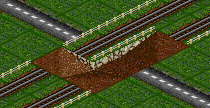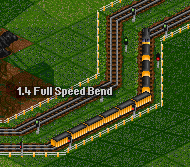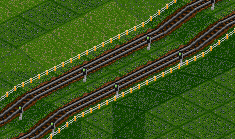Difference between revisions of "Tutorial Savegame Mainline"
From #openttdcoop wiki
m (→1.5 Stepped Climbing) |
(Grammar, spelling, and content) |
||
| Line 6: | Line 6: | ||
==1.1 Signal every 2nd tile== | ==1.1 Signal every 2nd tile== | ||
[[Image:Tutorial_Savegame_1.1.png|160px|frame|left]] | [[Image:Tutorial_Savegame_1.1.png|160px|frame|left]] | ||
| − | The purpose is clear; [[Mainline|Mainlines]] are designed for high throughput! | + | The purpose is clear; [[Mainline|Mainlines]] are designed for high throughput! Less-frequent signaling increases the spacing between trains, wasting capacity on the lines. |
<br style="clear: both;" /> | <br style="clear: both;" /> | ||
==1.2 Avoid Mainline Tunneling== | ==1.2 Avoid Mainline Tunneling== | ||
| − | In order to keep the signal blocks at 2 tiles (as mentioned in 1.1) you should try to avoid tunneling the [[Mainline]] by default. Bridge the [[Sideline]] instead! 2-tile-signaling on a mainline is useless if there is one single point with a 6-tile signal gap. <br style="clear: both;" /> | + | In order to keep the signal blocks at 2 tiles (as mentioned in 1.1) you should try to avoid tunneling the [[Mainline]] by default. Bridge the [[Sideline]] instead! 2-tile-signaling on a mainline is useless if there is one single point with a 6-tile signal gap. Trains will queue up right before the 6-tile gap, and the capacity of the mainline is determined by its most congested part. |
| − | + | <br style="clear: both;" /> | |
==1.3 Anti-Roadcross-Trackpart== | ==1.3 Anti-Roadcross-Trackpart== | ||
[[Image:Tutorial Savegame 1.3.png|210px|frame|left]] | [[Image:Tutorial Savegame 1.3.png|210px|frame|left]] | ||
| − | Sometimes, its necessary not to let a town cross your tracks - one reason may be that you need some space later on. Basically, there are two | + | Sometimes, its necessary not to let a town cross your tracks - one reason may be that you need some space later on. Basically, there are two possibilities: buy up land or build a construction as shown on the screenshot. The last option is more elegant and doesn't add ugly signs to the landscape. |
| + | <br style="clear: both;" /> | ||
==1.4 Full-Speed Bend== | ==1.4 Full-Speed Bend== | ||
[[Image:Tutorial Savegame 1.4.png|190px|frame|left]] | [[Image:Tutorial Savegame 1.4.png|190px|frame|left]] | ||
| − | Remember: S-bends are full-speed! | + | Remember: S-bends are full-speed! It's perfectly acceptable to make bends on the [[Mainline]], as long as there are no slowdowns. Some small bends ease up construction and may save costs. <br style="clear: both;" /> |
==1.5 Stepped Climbing== | ==1.5 Stepped Climbing== | ||
Revision as of 03:00, 18 July 2007
1.0 Mainline
This section belongs to Mainline related tips and tricks.
1.1 Signal every 2nd tile
The purpose is clear; Mainlines are designed for high throughput! Less-frequent signaling increases the spacing between trains, wasting capacity on the lines.
1.2 Avoid Mainline Tunneling
In order to keep the signal blocks at 2 tiles (as mentioned in 1.1) you should try to avoid tunneling the Mainline by default. Bridge the Sideline instead! 2-tile-signaling on a mainline is useless if there is one single point with a 6-tile signal gap. Trains will queue up right before the 6-tile gap, and the capacity of the mainline is determined by its most congested part.
1.3 Anti-Roadcross-Trackpart
Sometimes, its necessary not to let a town cross your tracks - one reason may be that you need some space later on. Basically, there are two possibilities: buy up land or build a construction as shown on the screenshot. The last option is more elegant and doesn't add ugly signs to the landscape.
1.4 Full-Speed Bend
Remember: S-bends are full-speed! It's perfectly acceptable to make bends on the Mainline, as long as there are no slowdowns. Some small bends ease up construction and may save costs.
1.5 Stepped Climbing
A so called stepped climbing means that you try to avoid a two-tile-uphill. Its not only something which slows trains down; its also ugly and non-realistic. If you construct uphills in a stepped way it looks far more like a Mainline.



